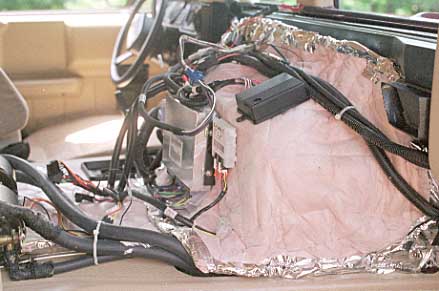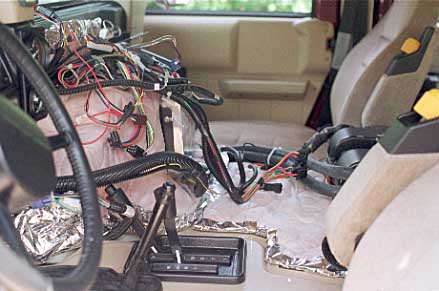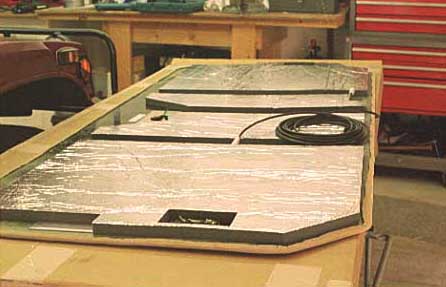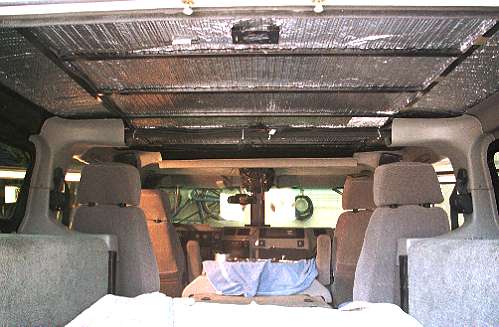Sound and Heat Insulating a
Diesel Hummer
Sound Insulate a Gas Hummer
New Insulation Article
Updated February 3, 2014
New Products Since I wrote the original article:
Looks like soundproofed valve covers might be a good option for our diesel trucks.
The latest weapons in the noise battle are steel-laminates, counteractive sound systems and tires that tread quietly.Several automakers, including GM, Ford, Chrysler and Mercedes, are using "quiet steel," in which two layers of steel are separated by a polymer. Ford was the first with the 1999 Explorer.
"Manufacturers used to allow noise into the cabin, then try and deaden it. Now they design the body to prevent noise from entering," The technology started in the 1980s with the brake industry, trying to solve brake squeal. Then it spread to powertrains and engines [valve covers in diesel motors for example] and finally into bodywork.
The next significant application will be the cowl plenum, the area around the windshield, which includes the dash, roof and A pillars, he says. "It's attached and it vibrates and rain hits it--it's all noise coming right at you." Note: the newer Hummers have foam in this area.
As far back as 1990, Lexus used foam-filled A-columns on the LS400 to control noise, according to Williamsen.
Tiremakers also are working to conquer the three types of noise. The first is airborne noise. You can hear the sound of the tire rolling, like a voice. The second is vibration. The road hits the tire, creates vibration to the wheel, the wheel to the suspension and the suspension to the vehicle. Each vehicle makes a different sound; we match the construction of the tire to different cars. The third is the wheel cavity. The tire is an air chamber, like a timpani or a kettle drum and 250 hertz equals the key of C. If you put a small chamber inside the larger one, it doesn't make any noise. That's simple physics.
Advanced Thermal Products makes covers for other engines.
The heat rising up through the shifter and the hot tunnel walls.
The heat is not from exhaust flow. It is a combination of convective engine heat (hot air) traveling down the tunnel and radiative heat from the exhaust pipe. The heat radiates up to the tunnel walls and heats the interior. The shield reduces the radiative component. Have you noticed that the panel your leg rests against also gets hot, that is from the radiative component. The boots reduce the convective flow.
Just thought I would share a success. I have a 94 NA truck that gets real hot around the shifter and parking brake lever on long runs. Hot air would come up through the gaps around the levers. The driveshaft and exhaust pipe run directly under this console. The heat from the exhaust pipe radiates directly on this entire area. I figured if I could add a reflector between the exhaust and the console I could reduce the heat load.
Sure enough, I installed a piece of stainless steel sheet and the heat is dramatically reduced. The hardest part is drilling and installing the screws, but well worth it. I put a gob of sealant on each screw to keep any water from leaking around the screws. Here are two photos. There is still room to get out the oil filter.See Pictures
AMG is using a new product to reduce the noise levels in their 2004 trucks called "HUMMER Coat". It is a spray-on water soluble, non-flammable & heat resistant polymer coating and can be ordered from your Hummer Dealer.
I applied 3 coats of Hummer coat to the underside of my hood, front foot-wells (directly behind front tires) and inside the rear quarters. I used and small roller and a small brush for the corners. It was very time consuming having to clean everything with degreaser 2-3 times to make sure the product would adhere properly. I am not happy with the result but it does look alot nicer. No change in noise level from the engine or road / tire noise. I think that investing the money into foam or fiberglass insulation in the engine compartment is a better choice. I will be doing this this spring/summer.
According to Quiet Solutions AMG uses Noise Killer 207 on the Hummers. This has to be the thick brushed on coating that you see on the outside of the truck in the wheel wells on 1998 and newer trucks. Painting this material on the outside of the body panels and on the inside of the doors is probably the best way to silence your truck. Talk is that in 2004 AMG will go to a "encapsulated" aluminum body process whatever that means?
Another company that makes coatings for sound and rust prevention is: http://www.tectyl.com/
American Micro Industires - The Acoustical Vinyl Barrier has an STC of the following values: 1/2 lb is 20, 1 lb is 27, 2 lb 31. Acoustical Vinyl Barrier is available in 4’ x 8’ sheets or 4.5’ x 60’ rolls. This 1/8 inch thick material is a dense, limp-mass vinyl that is 6 dB more effective than a sheet of lead at stopping sound transmission. Use it as a thin sound barrier layer in walls, ceilings, or floors as part of a multi-layered construction scheme involving acoustical foam. $288.00/roll Can withstand continued exposure to 275 deg. temperatures Arrived on a pallet with approx. shipping weight of 200 lbs. http://www.soundprooffoam.us 1-800-558-2058
The material I used to insulate the truck is a 2" fiberglass quilted lead sheet product used to insulate marine diesels. I bought a 4' x 8' sheet and some edge tape for $280.00. The material keeps the sound and heat from getting into the cabin from the engine area.
The lead sheet is available from Soundown Corp. in Marblehead, MA 800-359-1036
This is another company that produces a similar material that can be ordered with a silicone exterior on the lead/fiberglass quilt which resists tears, water and temps to 550 degrees. Product is ABSC26 2lb.
Comes in 4' width and you decide length. Price was $12.17 a square foot. Also pick up a roll of silicon edge tape if you are going to cut your own pieces.
www.acousticalsolutions.com
There is a distributer called B Quiet that carries a full line of sound insulating materials
http://www.b-quiet.com
This truck is now quieter then a new 98 Hummer. The headliner and roof insulation keep the inside noise level and temperature at a normal level. Noise is caused by the engine and drivetrain, wind and the tires / suspension working. Noise enters the truck through any hole such as the shifter lever area. AMG makes a newer boot that seals this up. AMG began to use a thick black tar on the outside of the body panels in the wheel wells. In 1999 they started to fill the A piller (around the windshield) with foam. I was told that there was a lot of resonance in this area.

Shows the Insulation surrounding the "Doghouse"
or the rear engine cover.

Additional material is installed over the tunnel hump area
under the aux heater / ac unit.In addition I installed lead sheet over the top of the transmission and transfer case under the truck. I also pulled a couple of sheets behind the engine against the firewall. I got very good results from the outside insulation so try to do it. I laid on my back under the truck on a creeper and shoved the insulation up in the tunnel over the trans and pulled it back over the tcase. Keep it away from the shift linkages and watch the wires. I then fed a section up from the bottom behind the engine bell housing and pulled it from the top up and behind the turbo. It's pretty tight over the turbo so it held. I tucked the material under anything I could find to keep it in place. I would rather have had it fastened in some way but it was almost impossible to do. You could take the doghouse and engine cover off and work from the inside and possibly glue the stuff to the truck. I put the insulation behind the engine starting at the turbo, not on top of the engine at all. There is not much noise actually getting in from the top of the engine.
The best thing to use to seal around the hoses is a clay substance used by electricians. They use it for the same purpose in electrical boxes. I also have seen a black tar substance that works like clay. Don't use spray foam. It will be a major mess to remove and break apart in case you have to service. You can insulate the shift lever by getting the underside boot that they use on the 98 and newer trucks. It is an aluminized cloth with snaps. Otherwise I have just shoved fiberglas in the area under the shifters.The headliner on a 1996 is made from a solid plastic material that doesn't insulate for heat or sound. All the interior panels in this truck were covered with matching foam backed headliner taken from the Cadillac upholstery book. The panels were then backed with 1/2" foam. The metal roof had Reflectix aluminum backed bubble wrap insulation glued on before the headliner panels were replaced.

The 1997-8 front headliner section showing padding, insulation
and coax cable for CB antenna.

Reflectix Insulation on Ceiling
Notes from the field:
11/14/2002
We've installed Dynamat, Roadkill, Rhino lined interiors, heat/sound insulation, you name it. While Dynamat is a good product, it has no buisness in a Hummer. It will
help a little, but the cost effectiveness is not worth it. You would need to take a reading to notice the results. All these are great products when used for what they are designed for. The best effect of reducing engine and driveline noise in a Hummer that I
have found is using a product similar to what Chuck Kopelson has on his website. The difference in the product we use is it has a silicon outer barrier which is heat and water resistant. There is a layer of fiberglass a layer of lead or vinyl and another layer of fiberglass. I constuct panels and install them over the engine and down on the drivers side, behind the block, over the bellhousing and down over the tranny and t-case. So
basically between drivetrain and body. If we have the body off, we secure it to the body in larger sheets.
We purchase it from:
http://www.acousticalsolutions.com
Salesman is Michael Binns
Product is ABSC26 2lb.
Comes in 4' width and you decide length
Price last time I ordered was $12.17 a square foot.
Also pick up a roll of silicon edge tape if you are going to cut your own pieces.
Sprayed on a thick coat of "cool car
Ceramic" product composed of 80% innovative air filled micro- ceramic and
silicon beads. Used 2 gal Cost $150. e-mail: orders@rbsauto.com
Next used Hamilton Jet products. Barrier 104 loaded vinyl mass barrier with
acoustical foam absorber and decoupler,( uses heavy clay-like substance
between sheets) & Aluminized polyester film. Used this under the dog house
double sheets. Next covered rest of bottom & wheel wells with Barrier 155 a
three layer vinyl filled loaded foam.
Another Method
I have discovered a very inexpensive sound insulation product called duct liner. It is simply the product that plumbers use to line the insides of return air ducts in forced air furnace applications to reduce noise transmission through sheet metal ducts. Most plumbing shops that make sheet metal ducting stock it. The product is available in various thicknesses, in my case I used the one inch material which cost only 90 cents Canadian per square foot. It is a fibreglass based product, grey in color, with a reinforced side on one side that is virtually black. It looks exactly like what you would find under the hood for insulation on an earlier pickup. I insulated the underside of my hood, as well as the doghouse with excellent noise reduction results. I also made a boot out of it that goes around the shifter boot underneath the truck. Under the hood where the cut edges of the insulation are visible, I smeared black caulking on the cut faces to match the reinforced exposed side and to make them more durable, before installing it. To attach it, I used aerosol spray contact adhesive. I also put a couple of coats of black spray paint onto the reinforced exposed side to make it more tear resistant. The finished hood insulation looks stock and made a noticible difference in noise by itself.
The doghouse area was a little more difficult as the product does lend itself well to curved surfaces. It wants to straighten out when not held in position and does not stretch. I ended up making a four piece blanket that fit together like a puzzle against the doghouse, using cardboard to make a template and then cutting the pieces of insulation from the template.
Actually ... sound is amplified by/ resonates through the C-section of the A-Beam & pillars. It is true the original (1984-1985) HMMWVs did have sound insulation on the underside of the hood, however it was later tested and proven more effective to insulate the A-Beam (horizontal) and inside A-Beam pillars (vertical) in reducing interior sound levels.

